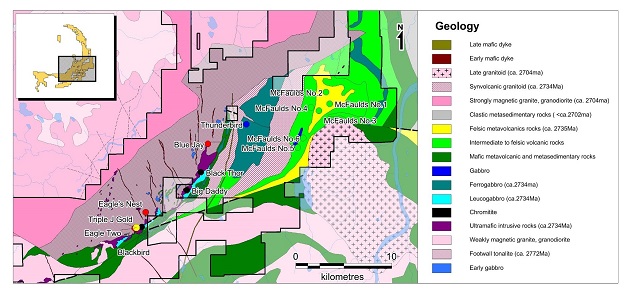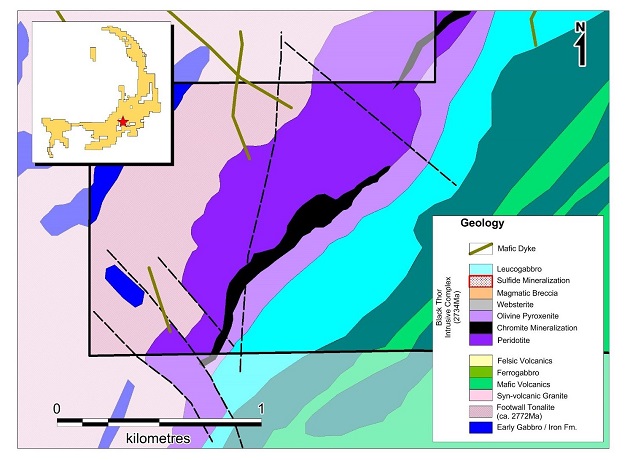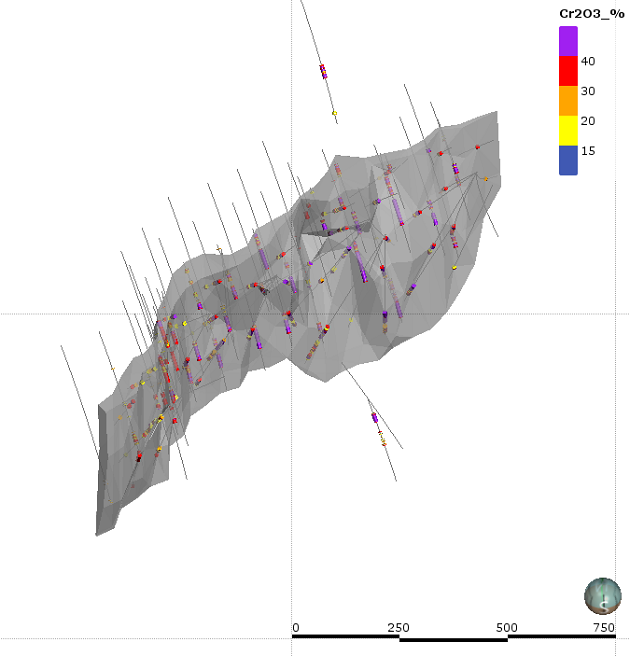Noront Resources Ltd.
Big Daddy Deposit

Overview
The Big Daddy chromite deposit is located 5 km northeast of Eagle’s Nest. In 2006, hole FW-06-03 intersected two narrow bands of massive chromite in what would later become the Big Daddy deposit. This intersection was the first known chromite mineralization to be discovered in the ROF. However, it was not until 2008 that the potential size and grade of the deposit became understood. Currently, the deposit is known to have the highest-grade accumulations of chromite ore in the region.
The Big Daddy Deposit is held jointly by Noront (70%) and Canada Chrome Mining Corporation (30%), owned by KWG Resources. Noront acquired its majority interest with the acquisition in 2015 of Cliffs’ ROF assets, which included both the Big Daddy and Black Thor deposits. The Big Daddy deposit represents a significant pipeline chromite project for Noront which will be developed over time after mining of the Blackbird and Black Thor chromite deposits.
Deposit Geology & Mineralization
Regionally the Big Daddy deposit is associated with an ultramafic sill complex situated at the contact between a large tonalite body to the northwest, and an overlying volcanic sequence to the southeast (figure 1). At over 16km in strike length and up to 1.5km in thickness, this sill complex is believed to consist of at least two individual sills known as the Double Eagle Intrusive Complex and the Black Thor Intrusive Complex. Both contain an ultramafic keel and/or feeder dyke with attendant Ni-Cu-PGE mineralization, overlain by a crudely layered ultramafic sill with thick accumulations chromitite.

FIGURE 1- REGIONAL GEOLOGY OF THE SOUTHERN ROF
The Big Daddy deposit is situated within the larger Black Thor Intrusive Complex, an overturned layered ultramafic sill-like body that also hosts the Black Thor and Black Label chromite deposits as well as the Blue Jay (AT12) and Contact Zone Ni-Cu-PGE occurrences. Coarse layering in the host ultramafic sill progresses from basal peridotite units upward into chromite mineralized dunite and peridotite into pyroxenite and finally a capping gabbroic unit. Ultramafic protoliths have all undergone varying degrees of serpentinization and talc-chlorite alteration. The chromite deposits in the ROF are globally quite rare and geologically similar to the Kemi chromite mine in northern Finland, currently operated by Outokumpu.

FIGURE 2- BIG DADDY GEOLOGY MAP
Chromite mineralization at Big Daddy is present as thick (up to 60m), sub-vertically dipping layers of fine-grained, heavily disseminated to semi-massive to massive chromitite continuous along strike for over 1.4km (figure 2).

FIGURE 3- 3D MODEL OF THE BIG DADDY CHROMITE DEPOSIT. OBLIQUE VIEW LOOKING NORTH.
Project Details
Exploration to date has consisted of geophysics and diamond drilling that has traced the chromite zone over a 1.2 km strike length and roughly 490 m down dip. A preliminary economic analysis (PEA) was conducted in 2011 by KWG Resources, which is the 100% owner of Canada Chrome Mining Corporation. Noront is the largest shareholder of KWG Resources.
Project Status
Noront is currently reviewing the technical documentation for this site. Our goal is to produce a strategic plan and a comprehensive preliminary economic analysis (PEA) for all of the development options for the Ring of Fire chromite projects.
Current resources for the Big Daddy deposit are presented in the Table below.

Cut off is 20% Cr2O3. Please see report titled “National Instrument 43-101 Technical Report: Black Thor, Black Label and Big Daddy chromite deposits: McFaulds Lake Area, Ontario, Canada, Porcupine Mining Division, NTS 43D16, Mineral Resource Estimation & Technical Report” by Alan Aubut of the Sibley Basin Group, released July 27, 2015. CIM Definition Standards were followed for classification of Mineral Resources. The Mineral Resource estimate uses drill hole data available as of April 30, 2013 for the Black Thor and Black Label deposits and June 3, 2012 for the Big Daddy deposit. The cut-off of 20% Cr2O3 is the same cut-off used for the Kemi deposit as reported by Alapieti et al. (1989). Section 14.2 of the Technical Report includes a description of the key assumptions, parameters, and methods used to estimate the mineral resources. A copy of the Technical Report may be accessed under Noront’s company profile on SEDAR at www.sedar.com. Mineral resources that are not mineral reserves do not have demonstrated economic viability. The estimate of mineral resources may be materially affected by environmental, permitting, legal, title, socio-political, marketing or other relevant issues.
Source: https://norontresources.com/projects/big-daddy-deposit/
